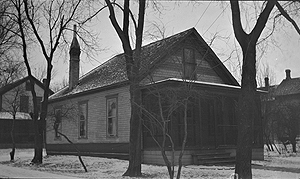|
|
||||
|
Richard Bostwick Reminiscences Welfare Office Stories Cab Driving Stories Prohibition Stories |
A Journey into Memory Reminiscences allow the present generation to take a journey into memory, whether our own memories or those of someone else in a different time and place. Richard Bostwick's reminiscences do just that. They take a reader back to an era we only read about in history books or hear about from our parents or grandparents. Bostwick's reminiscences gave his family, according to granddaughter Angie Weber-Morris, “a sense of getting to know Grandpa all over again. There are so many things that now made sense, so much I did not know before.”
That Richard Bostwick was a very perceptive person is very evident in his writings. He seemed to be keenly aware of his surroundings and the events that transpired, together with the ability to write them down in great detail. His reminiscences make for good history, providing rich, personal detail at the human level. In short, he was a good story teller. Today, you the reader are the beneficiary of his memory journey. In conclusion, we can only offer the advice of his granddaughter, “So please, take this and read them, share them, enjoy them. If you've already read them, then read them again. Pass them on to anyone you can think of that would enjoy them. I set out to give a gift, but actually got one myself—the gift of knowing that Grandpa is still with me, and that if I can just remember that when I need comfort, I have truly been blessed.”
|
|||
Further Reading
|
||||
Danbom, David B. Going It Alone: Fargo Grapples with the Great Depression. St. Paul, MN: Minnesota Historical Society Press, c2005. |
||||
This 1930s Depression history focuses on how the City of Fargo struggled to survive problems it could not solve itself and how federal policies and programs played out in a community of people who's culture was self-sufficiency and independence.
|
||||
Danbom, David B. Nostalgia isn't What We Used to Be: the Great Depression in Fargo in Memory and Reality. [Bismarck, N.D.]: North Dakota Humanities Council, 1999. Hudson, Lois Phillips. Reapers of the Dust: a Prairie Chronicle. St. Paul: Minnesota Historical Society Press, 1984. Low, Ann Marie. Dust Bowl Diary. Lincoln: University of Nebraska Press, 1984. Stock, Catherine McNicol. Main Street in Crisis: the Great Depression and the Old Middle Class on the Northern Plains. Chapel Hill: University of North Carolina Press, 1992. Tweton, D. Jerome and Daniel F. Rylance. The Years of Despair: North Dakota in the Depression. Grand Forks, N.D.: The Oxcart Press, 1973, [1974] |
||||
|
Institute for Regional Studies Home Page 701-231-8914 Published by the Institute for Regional Studies, NDSU Updated: 7/30/2007 |
||||
